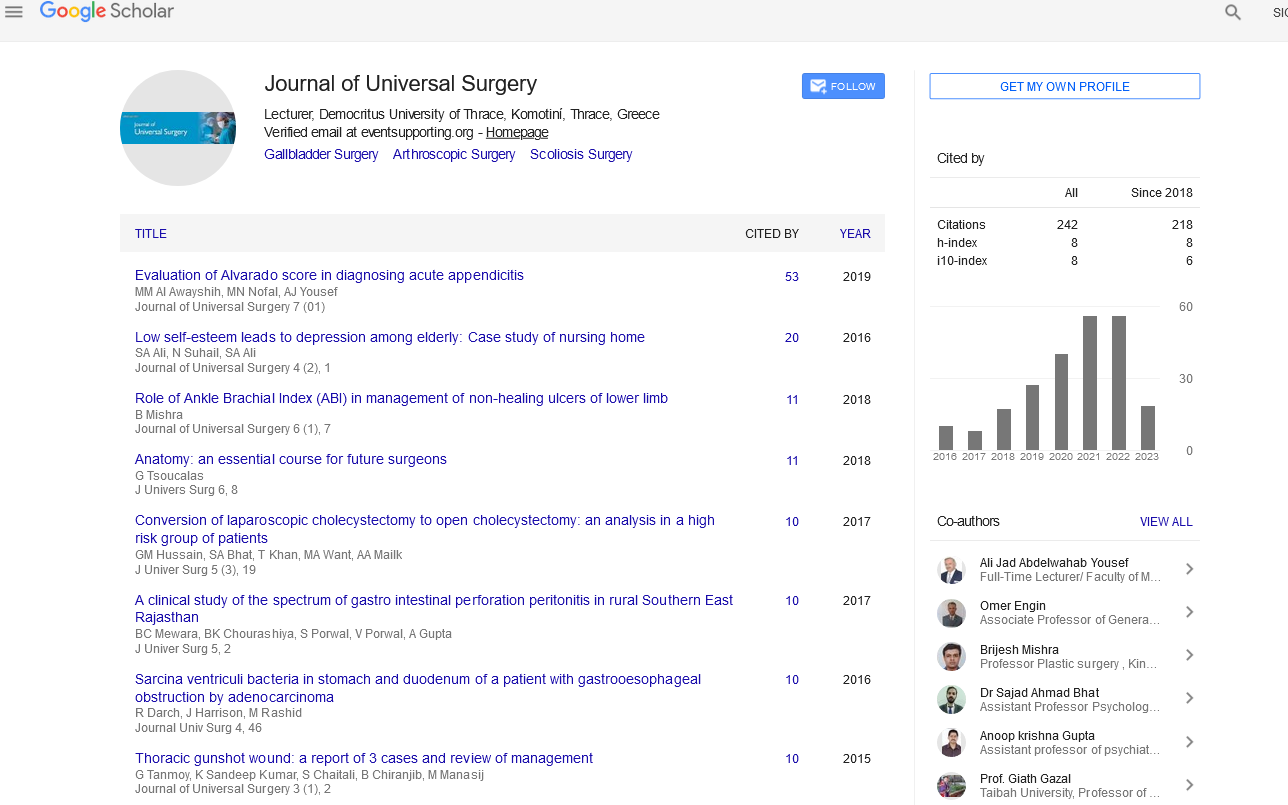Perspective - (2024) Volume 12, Issue 3
Satisfaction after Surgical Treatment for Idopathic Surgery
Addy Albenie*
Department of General Physician, Unversity of Kinsale, Kinsale, Ireland
*Correspondence:
Addy Albenie, Department of General Physician, Unversity of Kinsale, Kinsale,
Ireland,
Email:
Received: 15-May-2024, Manuscript No. IPJUS-24-14867;
Editor assigned: 20-May-2024, Pre QC No. IPJUS-24-14867 (PQ);
Reviewed: 03-Jun-2024, QC No. IPJUS-24-14867;
Revised: 24-Jun-2024, Manuscript No. IPJUS-24-14867 (R);
Published:
27-Jun-2024
Introduction
Idiopathic Scoliosis (IS) is a complex three-dimensional
deformity of the spinal column being the most common type of
spinal curvature. Adolescent Idiopathic Scoliosis (AIS) is the most
common type accounting for about 80% of idiopathic scoliosis
involving healthy individuals during puberty. The prevalence of
AIS has been reported to be 0.47%-5.2% of adolescent
population and school children.
The prognosis depends on several factors including curve
morphology, magnitude of curvature, age of onset, stage of
bone growth, and rate of progression that varies from curve
progression to stabilization or disappearance with growth.
Progression of the curves may result in several pronounced body
deformities, uneven shoulders, and asymmetric waist line that
subsequently leads to damaged body self image and mental
health, pain, spinal degenerative changes, several limitations in
activities of daily living, and in severe cases disturbed pulmonary
function.
Description
Surgical reduction of deformity may be required to improve
cosmesis and self-image while improving pulmonary function,
relieving pain, and preventing curve progression. The rate of
correction utilizing new instruments is reported between
60%-80% while postoperative bracing is not necessary.
It is shown that scoliosis causes mental dysfunction and
psychological problems involving both the patient and the family
in that the severity is not in accordance with the severity of the
disease based on physical and radiographic findings. Also,
several studies reported that objective success in correction is
not correlated with subjective satisfaction of the patient and the
family because their perception of appearance differs from that
of surgeon.
AIS is a challenging and bothersome deformity that can
adversely affect various aspects of the patient’s life. This
deformity significantly deteriorates the ability of independently
performing activities of daily living and contribution in social
activities. In addition to physical health problems which can be
life threatening in severe cases, the appearance of the patient
especially in females, affects the mental health, self confidence,
and self-image making them avoid participation in groups of
family, school, university, and other public societies. The
negative effects of AIS on psychological conditions and quality of
life have been shown in several studies.
Because of severe impacts scoliosis has on satisfaction and
quality of life, several studies tried to determine the effects of
treatment on these parameters. To achieve this goal, SRS
questionnaire became a useful tool, which was validated in
several previous studies. In a study by, SRS was more responsive
to changes at 1 and 2 years after surgery compared to Oswestry
Disability Index (ODI) and Short Form-12 (SF-12).
In the current study, we found that the rates of curve
correction and coronal balance correction can significantly affect
the total SRS-30 score. Also, we found that the rate of correction
was positively correlated with satisfaction. In other words, the
greater correction results in more satisfaction and better quality
of life. Between SRS domains, we found that only self-image was
positively correlated with satisfaction. Based on this finding, we
think that cosmesis and appearance is the most important factor
affecting patient’s satisfaction and quality of life. Although
patients with AIS travail from the pain and functional limitations,
it seems that the most important obsession of these patients is
the appearance which should be considered in treatment
planning.
There are several factors regarding dissatisfaction or
neutrality about the outcomes of treatment including
preoperative physical characteristics, psychological problems,
impractical assumption regarding the postoperative cosmesis,
type of the curve and high thoracic apical translation. Found
that only half of the patients with severe AIS were satisfied with
the postoperative cosmesis. They showed that King II or King IV
curves are associated with less correction and displeasure of the
outcomes. In a study by Sanders et al, patients with less spinal
appearance issues were less satisfied with the outcomes.
However, in our study we found no significant difference
between different types of AIS based on King’s classification. Like
other studies, our study has its own limitations. We did not
have the preoperative SRS score to demonstrate the
improvement after surgery. We used the Persian SRS 30
which was comprised of the SRS 22 that was already validated
plus 8 more items that were added only after simple translation.
Conclusion
In conclusion, greater radiographic correction of the AIS
through surgery is associated with higher satisfaction and SRS-30
scores. Satisfaction was correlated positively with self-image/
cosmesis score as well. It seems that cosmesis is the most
important factor affecting patient’s satisfaction after surgical
treatment.
Citation: Albenie A (2024) Satisfaction after Surgical Treatment for Idopathic Surgery. J Univ Surg Vol.12 No.3: 030.





